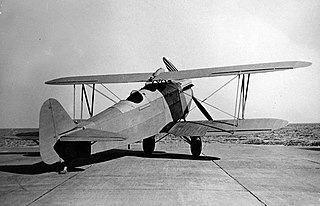Operators
 Japan
Japan
| Aichi Experimental Type 15-Ko Reconnaissance Seaplane (Mi-go) | |
|---|---|
| Role | Reconnaissance seaplane |
| Manufacturer | Aichi Kokuki |
| First flight | 1925 |
| Primary user | Imperial Japanese Navy |
| Number built | ~4 |
The Aichi Experimental Type 15-Ko Reconnaissance Seaplane (Mi-go) was a prototype reconnaissance seaplane built by Aichi in the mid-1920s.
The Mi-Go was built in response to an Imperial Japanese Navy (IJN) requirement for a reconnaissance seaplane to replace the Hansa-Brandenburg W.33 in IJN service. The W.33 had been acquired by the IJN in 1922 but was unpopular with crews due to poor handling and limited visibility afloat. The Mi-Go differed from the W.33 in having floats connected to the wings, a wooden airframe, fabric covered wings, and much lighter weight. Four prototypes of the Mi-Go were built; tests of which showed it to be longitudinally unstable in flight, although the first prototype used Dornier bench-type aileron balances, and the IJN selected the rival Nakajima Type 15 Reconnaissance Seaplane (E2N) for production instead. [1]
Data fromJapanese Aircraft, 1910-1941, [2] airwar.ru [3]
General characteristics
Performance
Armament

The Mitsubishi F1M is a Japanese reconnaissance floatplane of World War II. It was the last biplane type of the Imperial Japanese Navy, with 944 built between 1936 and 1944. The Navy designation was "Type Zero Observation Seaplane" (零式水上観測機).

The Yokosuka R2Y Keiun was a prototype reconnaissance aircraft built in Japan late in World War II.

The Aichi E13A is a long-range reconnaissance seaplane used by the Imperial Japanese Navy (IJN) from 1941-45. Numerically the most important floatplane of the IJN, it could carry a crew of three and a bombload of 250 kg (550 lb). The Navy designation was "Navy Type Zero Reconnaissance Seaplane" (零式水上偵察機).

The Aichi H9A was an Imperial Japanese Navy Air Service flying boat used during the first years of World War II for crew training. An uncommon type, it was not encountered by Allied forces until Spring 1945 and was never assigned an Allied reporting name.

The Nakajima E4N was a Japanese shipboard reconnaissance aircraft of the 1930s. It was a two-seat, single-engine, equal-span biplane seaplane used primarily by the Imperial Japanese Navy.

The Nakajima E8N was a Japanese ship-borne, catapult-launched, reconnaissance seaplane of the Second Sino-Japanese War. It was a single-engine, two-seat biplane with a central main-float and underwing outriggers. During the Pacific War, it was known to the Allies by the reporting name "Dave". This aircraft was identified by the British as the Nakajima KT-95 Dave.

The Aichi E16A Zuiun was a two-seat reconnaissance seaplane operated by the Imperial Japanese Navy during World War II.

The Heinkel HD 25 was a two-seat shipboard biplane reconnaissance floatplane developed in Germany during the 1920s for production in Japan.
The Heinkel HD 26 was a reconnaissance seaplane developed in Germany during the 1920s for production in Japan. It was intended as a smaller, single-seat counterpart to the HD 25, to provide a spotter aircraft for warships and to take off from a short ramp. The HD 26 was a conventional biplane with staggered wings, twin float undercarriage, and an open cockpit.

The Aichi E3A was a reconnaissance seaplane developed in Germany as the Heinkel HD 56 to operate from warships of the Imperial Japanese Navy, which designated it the Type 90-1 Reconnaissance Seaplane. It was a conventional single-bay biplane with staggered wings braced by N-type interplane struts. The pilot and gunner sat in tandem, open cockpits.

The Aichi E10A was a Japanese night reconnaissance flying boat of the 1930s. A single-engined biplane, 15 were built for the Imperial Japanese Navy as the Type 96 Night Reconnaissance Seaplane, serving from 1936 but were retired in 1941 before the Attack on Pearl Harbor.

The Yokosuka E1Y was a Japanese floatplane of the 1920s. A single-engined biplane that was designed and developed by the Yokosuka Naval Air Technical Arsenal as a reconnaissance aircraft for the Imperial Japanese Navy, 320 were built as the Type 14 Reconnaissance Seaplane, entering service in 1925 and remaining in operational service until 1932.

The Yokosuka Ro-go Ko-gata was a Japanese reconnaissance floatplane developed during the First World War by the Japanese Navy Arsenal at Yokosuka, and one of the first indigenous Japanese aircraft to enter production. There were 218 of these aircraft built for the Imperial Japanese Navy, which remained in use until 1928.

The Kawanishi E11K was a Japanese flying boat of the 1930s. It was designed as a night reconnaissance aircraft for the Imperial Japanese Navy (IJN) but was not accepted. The two aircraft that were built were used as transports as the Type 96 Transport Flying Boat during the Second World War.
The Aichi AB-6, or Aichi Experimental 7-Shi Reconnaissance Seaplane, was a prototype Japanese reconnaissance floatplane. It was a single-engined, three-seat biplane intended for the Imperial Japanese Navy, but only one was built, the rival aircraft from Kawanishi, the E7K being preferred.
The Yokosuka E5Y was a single-engine Japanese seaplane used for reconnaissance. The E5Y was also built by Kawanishi as the E5K
The Kawanishi E10K, also known as Kawanishi Type T, Kawanishi Navy Type 94 Transport Seaplane and Kawanishi Navy Experimental 9-Shi Night Reconnaissance Seaplane, was a small Japanese flying boat of the 1930s. It was a single-engined biplane intended to meet a requirement for a night reconnaissance aircraft for the Imperial Japanese Navy but was not selected for production, the single prototype being converted to a transport and operated as the Navy Type 94 Transport.

The Caspar C 30, aka Caspar LE 30 was an aerial reconnaissance aircraft developed in Germany and built in Denmark in the late 1920s.

The Heinkel HD 41 was a reconnaissance aircraft developed in Germany in the 1920s.
The Kawanishi E13K, company designation AM-19, was a Japanese 1930s three-seat reconnaissance floatplane.